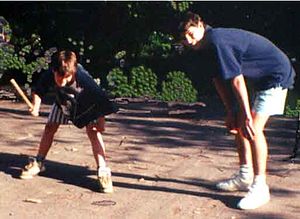- Gilli-danda
-
Gilli-Danda (Urdu: گلی ڈنڈا, Devanagari: गिल्ली डण्डा) is an amateur sport played in the rural areas and small towns all over the Indian subcontinent, as well as Cambodia.
Gilli Danda known by various other names: it is called Dandi-Biyo (डण्डी बियो) in Nepali, alak-doulak (الک دولک) in Persian, dānggűli in Bengali & Assamese, chinni-dandu in Kannada, kuttiyum kolum in Malayalam, viti-dandu विट्टी दांडू in Marathi, kitti-pullu in Tamil, Gooti-Billa or Karra-Billa or Billam-Godu in Telugu, Gulli-Danda (گلی ڈنڈا ) in Urdu, Iti-Dakar (اٽي ڏڪر) in Sindhi, Lappa-Duggi (لپا ڈگی ) in Pashto and Kon ko in khmer, the Cambodian language.
Contents
Origin
There are no records of the game's origin in the South Asia or of its existence before the arrival of Europeans. However a similar game known as Lippa has a history of being played in Italy and southern Europe and Tip-cat which was played in the UK. There is a reference to this sport in the medieval Telugu text "Palnati Veera Charitra" by Srinatha which was written in the later part of 13th Century.[1]
Equipment
The game is played with a gilli and a danda, both of which are wooden sticks.[2] The danda is longer, and the player can swing it easily. The gilli is smaller and is tapered on both sides so that the ends are conical.[3] The gilli is analogous to a cricket ball and the danda is analogous to a cricket bat.
There is no standard length defined for the danda or the gilli. Usually, the gilli is 3-6 inches long and the danda is 12-18 inches long.
Rules
The objective of the game is to use the danda to strike the gilli. For this purpose, a circle is drawn in the ground in which a small, oblong or spindle-shaped hole is dug (the overall shape looks like a traditional boat). This hole is smaller than the gilli but as the play progresses the size may increase due to wear. The gilli is inserted into the hole either orthogonally, or at an angle. Many times, especially with children, no hole is used. The danda is then swung downward onto the end of the gilli, causing the gilli to jump upward. The striker then strikes the gilli outward, away from him. Another variation is when the danda lifts or pries the gilli out of the hole at a high speed.
Scoring and outs
There are many regional variations to scoring.
The gilli becomes airborne after it is struck. If a fielder from the opposing team catches the gilli, the striker is out. If the gilli lands on the ground, the fielder closest to the gilli has one chance to hit the danda (which has to be placed on top of the hole used) with a throw (similar to a run out in cricket). If the fielder is successful, the striker is out; if not, the striker scores one score and gets another opportunity to strike. The team (or individual) with the most points wins the game. If the striker fails to hit gilli in three tries, the striker is out (similar to a strikeout in baseball).
Teams
There is no official maximum number of players or teams. Gilli-danda can be played where each individual plays for themselves, or between two teams.As Many Player you As much more fun.
Variations
As an amateur youth sport, gilli-danda has many variations. A common variation is where the striker is allowed to hit the gilli twice, once initially, and then while the gilli is in the air.
In some versions, the points a striker scores is dependent on the distance the gilli falls from the striking point. The distance is measured in terms of the length of the danda, or in some cases the length of the gilli. Scoring also depends on how many times the gilli was hit in the air in one strike. If it travels a certain distance with two mid-air strikes, the total point is doubled.
In Nepal, Dandi biyo is played in similar fashion.
Similar games
- In the Philippines, a game known as syatong is similar to gilli-danda.
- In Italy a similar game known as "Lippa", "Lipe", "Tirolo", or "S-cianco" is shown in the movie Watch Out We Are Mad.[4][5][6]
- In the United States, a similar game is called pee-wee.[7]
In popular culture
The Bollywood movie Lagaan mentions the traditional sport of gilli-danda as similar to cricket.
Premchand, the famous Hindi literary figure, wrote a short story named "Gilli-danda" in which he compares old simple times and emotions to modern values and also hints at caste inequalities in India.[8]
See also
References
- ^ Srinatha (13th Century). "Full text of Palnati Veera Charitra". Historical Text. http://www.archive.org/details/palnativeerachar022033mbp. Retrieved 2011-09-14.
- ^ Vinita Sidhartha (2001-06-09). "How to Play Gilli-Danda". The Hindu. http://www.hindu.com/thehindu/2001/06/09/stories/1309110a.htm. Retrieved 2011-09-14.
- ^ "People Are Knowledge - Gillidanda interview (oral citation)"]. Wikimedia Commons. April 2011. http://commons.wikimedia.org/wiki/File:PeopleAreKnowledge_Gillidanda_Interview1.ogg. Retrieved 2011-09-14.
- ^ Bud Spencer, Terence Hill e a Billarda
- ^ Y si no , nos enfadamos ( 2/10 ) - Juntos son dinamita
- ^ palio mazza e pivezo cesa (CE)
- ^ Frederic Gomes Cassidy, Joan Houston Hall (2002). "Dictionary of American Regional English". Belknap, Harvard University Press. http://books.google.de/books?id=i33BWgxbvXgC&pg=PA83#PPA83. Retrieved 2011-09-14.
- ^ Prakash Chandra Gupta (1998). "Makers of Indian Literature: Premchand". Sahitya Akademi, New Delhi. http://books.google.com/books?id=bTUt0PwnCaYC&pg=PA9&lpg=PA9&dq=premchand+gilli+danda&source=bl&ots=T9CYlPyIg7&sig=BbQOcUwCzbRD4rk5sjwc6XDU4Vg&hl=en&ei=jFV9ToCkCMHTrQezvujtAw&sa=X&oi=book_result&ct=result&resnum=5&ved=0CD0Q6AEwBA#v=onepage&q&f=false. Retrieved 2011-09-24.
External links
Categories:- Sport in Pakistan
- Traditional sports of India
Wikimedia Foundation. 2010.

